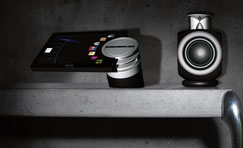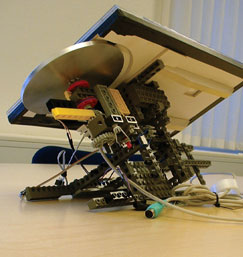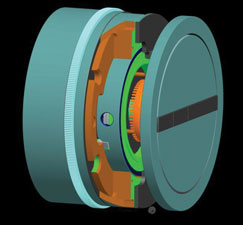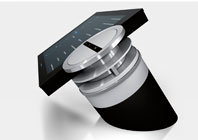
The BeoSound 5 controller features a 10.4-inch LCD display and an aluminium navigation wheel
There is an aura that surrounds Bang and Olufsen’s products – it’s almost as though they have been touched by magic, whether it’s a CD player that opens with the wave of a hand or a plasma screen TV that swivels to adjust itself to your viewing position.
Built on more than 80 years of Danish craftsmanship and innovation the audio visual manufacturer is renowned for its distinctive range of televisions, music systems, loudspeakers and multimedia products. More recently it has added mobile phones to its portfolio, plus premium sound systems for automotive companies including Audi and Aston Martin. Bang and Olufsen’s products may come with a rather hefty price tag but customers are willing to spend more on technologically excellent products that come in a stylish package.
Towards the end of last year, under a shroud of mystery, the company unveiled a new product – BeoSound 5, a high-quality digital audio player that is intended to bridge the gap between its high-end hi-fi systems and those that store music digitally. At the heart of the system is the BeoSound 5 controller – a 2.65kg tabletop or wall mounted remote that features a 10.4-inch LCD display and an aluminium navigation wheel. The wheel allows users to scroll swiftly through their music collection as well as over 8,000 Internet radio stations with every move mirrored on the screen in an array of colours, fonts and choreographed graphic displays.
BeoSound 5 runs on B&O’s new intelligent playlist system – ‘More of the Same’ or MOTS. As the company describes it, playing a song is like planting a seed – whenever you start playing your favourite music, MOTS automatically scans your library and finds similar tracks based on parameters such as rhythm, syncopation, key tonality and vocal harmonies. Also included in the package is the BeoMaster 5, a discrete black box that provides 500GB of storage and all the electronics required to drive the system.
BeoSound 5 started its life in B&O’s ‘IdeaLab’ as a user interface exploration. IdeaLab was set up in 2004 as a new department to look specifically at digital concepts and acted as a supplement to the existing design department IdeaLand. These two departments have since merged to become IdeaFactory. Oliver Wallington was one of the early members of the IdeaLab department. Having graduated in Industrial Design from Brunel University he spent eleven years working as a design contractor for LEGO, amongst other companies, and four years ago moved to Struer, Denmark, where he took up the position of concept and prototype developer at B&O. “My primary role has been looking at function and product concepts specifically in the digital technology area. This has naturally led into some user interface work,” he explains. “My projects are a mix of ‘briefs’ from the company and my own initiatives.
“Its hard to define a concrete process as this very much depends on the project, some are very conceptual where we look at trends in user behaviour whereas others could be the actual function and interface on next year’s DVB module.”
Cue the music
Through his exploration and concept work into digital platforms and connections it became apparent to Wallington that due to the huge amount of content that could potentially be held in hard drives, new navigation solutions for audio/video (AV) products would be required. However, it was not merely a case of trying to improve on existing solutions; he wanted to completely reconsider navigation due to the volume of content. “At the same time we realised that B&O needed to be more confident in the screen space, the graphic and animation quality of our pixels did not match that of our physical design. A natural step in this process was to look at on screen menus/navigation,” adds Wallington.

B&O’s IdeaLab uses a wide range of prototypes. These can include anything from computer animations or simulations to stand alone working demos, which use a mix of LEGO, cardboard, and computers
So, he started looking at literal connections between moving mechanics and graphics. In order to explore this more fully he created a basic prototype of a wheel interface that could be attached to the back of a tablet PC. “With the interface we were looking at the on-screen graphics being animated in a way that the movements correspond directly to the mechanical movement of the physical wheels. The idea is that the graphics appear to be physically connected in some way to the interface, thereby giving an overall more mechanical feel,” explains Wallington. “B&O has a long tradition in mechanical interfaces and mechanically moving parts so we considered it interesting if the screen graphics could continue this story.”
Using this prototyped hardware, Wallington and his team experimented with many different kinds of interactions, graphic layouts and functions. They also made further models using cardboard, LEGO and computer parts, and optimised their software for these. “Although these prototypes are unlikely to win any design prizes, they can tell you a great deal about what is needed to ensure good functionality,” he adds.
It was only then that Wallington started to consider where this could be applied and for a number of reasons decided to focus on developing a home audio product. This decision was also influenced by the work that was being carried out by the MOTS development team who were actually sharing Wallington’s workspace in IdeaLab. “We were playing with some ideas of what we could use the interface for and a strong direction was audio. There were also many people talking about MOTS however, there had been no explorations of a product interface for it. As we were making interface prototypes as a part of exploring the graphic/mechanic connection we thought we might as well add MOTS functionality and see how that would affect the navigation,” explains Wallington.
The prototyping department then made a better hardware platform for Wallington and his team who continued making user interface iterations for it using Adobe Director. “While the interface could potentially be used to control many things we wanted to purely focus on digital audio. Similarly, we explored its position and use in day to day scenarios with a remote control,” says Wallington. “We wanted the product to have a very clear and definite purpose and we wanted to develop a known product category rather than create a new one.”
It was only at this point that the concept was presented to top management who agreed that it could be made into a B&O product. The designer Anders Hermansen, who had previously worked on B&O’s earset and earphone products, then came onboard. “The designer was concerned with the use of buttons on the early prototypes to select between navigation options,” says Wallington. “He perceived an issue in two handed operation as the user may have a glass of wine in one hand. Due to this the navigation options were then selected by a lever under the wheel that points to the option on screen. This also gave a good interface benefit as the physical buttons could constrain us in future updates and the lever is far more flexible.” In developing this lever idea some new test prototypes were made using smashed up joysticks to simulate the lever input.
Working in harmony
Together with the designer a team of concept and user interface developers, mechanical and electrical engineers, software developers, production planners and many others became involved in the project. “We were trying to speed things up by working in parallel and taking in all relevant inputs into account in the very early stages of the development,” explains Jorgen Daucke, concept manager in IdeaFactory. “It was a tough job because we had to optimise mechanics, optical encoding, player software at the same time as finding the right design expression and make it hang together with moving graphics on the screen.

Bang and Olufsen’s mechanical designers use Pro/Engineer and take advantage of a number of features including Mechanica, Plastic Advisor and BMX (Behavioural Modelling eXtension). For calculations they use Mathcad and Windchill for data management
“The job was to make the covers and tags stick to the wheel in a convincing one-to-one manner. In my opinion we succeeded in not making a display with a wheel – we made a wheel with a display instead.”
This was very much a prototype-focussed project and having a small prototype department in-house was hugely beneficial in executing one off models in order to gain hands on experience. “The interplay between Pro/Engineer and fast [rapid] prototyping is very helpful, but from a concept manager’s viewpoint it can never be fast enough,” comments Daucke. “When you build models you have to have a clear focus as to what they must show – is it a design model, an interface prototype, a display/front glass model, a tactile response model?
“If you try to build it all together in one model during the early stages of development complexities will arise and delays will occur. The trick is to keep models simple and independent if possible.
As much of the project had to happen in parallel the various prototypes also added communication between all those involved. “I would argue that the development of the product was very centred around prototypes – the nature of the product requires function, interface, design and mechanics to hang together and a combined prototype was the best way to communicate,” he says.
Closing notes
Once the designer had refined his design and the user interface team had completed the final function space the project was then handed over to the R&D department for more detailed development. From here the BeoSound 5 went to manufacture, was revealed to the public last November and will be available to buy from one of B&O’s 1,200 exclusive retail stores starting this month. The company obviously has high hopes for this product with B&O’s CEO Kalle Hvidt Nielsen referring to it as a “breakthough product” at the launch.
“I think it is fair for Kalle to describe the BeoSound 5 as a breakthrough product, there really is nothing else like it,” says Wallington. “It has really challenged the conception that the home stereo product position is invalid due to computers and media centres.
“We feel that it is very much a living room/home product that has managed to take the benefits from the PC environment without the PC tone of voice. One of the best compliments I have heard as a developer on this product was that it is “very B&O”, and that is hard to describe.”
However, like many companies B&O has also been affected by the current global economic slowdown. As part of its Pole Position strategy plan announced last October, the company is currently streamlining its product development to make it possible to increase the number of product launches. Nielsen argues that stronger product concepts are needed in B&O stores to improve turnover and he is confident that these are already in the pipeline. However, this has meant that as many as 220 employees in Denmark and abroad have had to be laid off. Although regrettable, Nielsen said in a statement released during January that B&O has no choice but to adapt to changes in the market and the current economic situation.
However, despite the climate Wallington says that B&O is still one of the most exciting places to work at the moment from a concept viewpoint. He feels that the whole AV category is undergoing a major shift due to digital technology and this presents an opportunity for B&O. “The things that originally motivated me to work for the company were the quality and the distribution chain. If you are working a lot with ideas you want to see them made well. Also, the Bang & Olufsen shops mean you can come up with genuinely new product concepts as there is a space and knowledgeable staff to introduce and communicate these,” says Wallington.
“These are still key for me in terms of working for the company however after a few years here I would also add that it is a company that respects individuals, allows them to grow and define their own role.”
www.bang-olufsen.com
How Bang and Olufsen got in tune with RP to unveil its latest innovation






